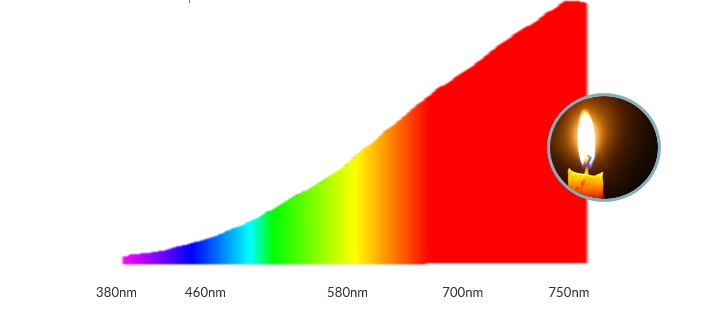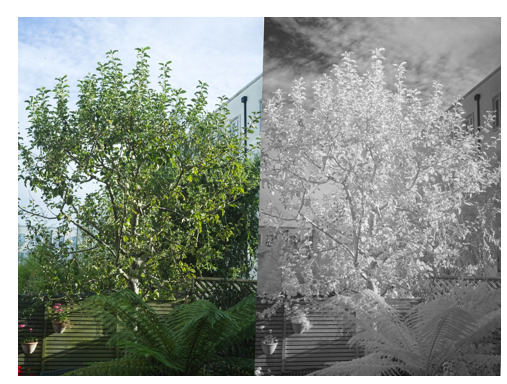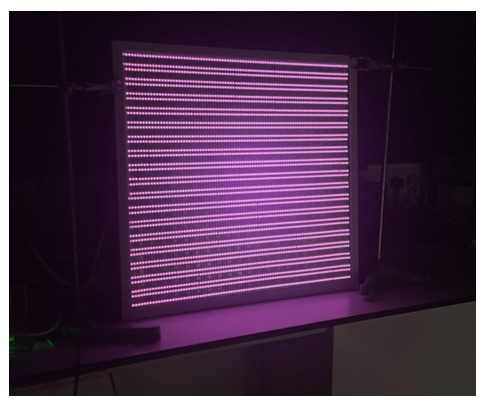Insights
Seeing red: Our need for infrared light.
The importance of light spectrum.
Recent research indicates that because LED light sources contain no infrared energy, we might be missing out on vitally important wavelengths. Humans evolved over millions of years under daylight that has a balanced distribution of long and short wavelengths – a “broadband” spectrum:

As we have come to spend more time inside buildings, we have created light using other means. The earliest artificial light used incandescent sources (i.e. burning things, and latterly tungsten filament lamps), which have a spectrum characterised by little energy at the blue end of the spectrum and lots in the red end:

With the advent of other types of artificial light, the spectral characteristics have changed, with increasing drive to make the light as efficient as possible by delivering energy within
the visible part of the spectrum and minimising “wasted” non-visible radiation. This has culminated in LED, which is now our default light source in the built environment. The spectral profile of LED varies considerably between sources, but is generally characterised as follows, with virtually no radiation outside of the visible light wavelengths.

Scientists at UCL (Professors Glen Jeffrey and Bob Fosbury) have undertaken research into the links between Infrared (IR) and Near-infrared (NIR) light and human health. They believe that the removal of IR wavelengths from artificial light could have serious health consequences, given that we are now mostly indoor-dwellers. According to them:
Longer wavelengths (650-900nm) that are now mainly absent are associated with improved physiology via manipulation of metabolism. They positively influence mitochondria that supply our bodies with cellular energy. They penetrate deeply and are absorbed by mitochondria that then change signalling in our blood so that this information is spread throughout the body.
“Shorter wavelengths, particularly those between 420nm to 450nm, undermine mitochondria and are associated with reduced cellular energy. Our understanding here is based on multiple published studies by a number of different international groups.” In other words, short wavelengths (from the blue end of the spectrum) deplete cells of their energy, while longer wavelengths (from the red end) supply our cells with energy. The health of mitochondria is critical to a wide range of processes in the body, most notably cell regeneration and tissue repair.
We already know about the importance of 480nm light for our circadian system, so this new understanding points to the importance of balancing the blue end of the spectrum with energy from the red end. Read more on the guide to circadian lighting here.
Why we need daylit buildings.
One answer is to ensure that indoor spaces are well daylit, so that the deficiency of IR in artificial lighting is not a problem. But this is only a partial solution, since commercial buildings are routinely fitted with glazing that is treated to minimise solar heat gain (low-e or solar control glazing), designed to filter out IR radiation. Currently, domestic buildings in the UK generally do not have solar control glazing.
The power of plants.
The research at UCL has pointed to the role of plants in reflecting IR and NIR light in interiors. Plant leaves are excellent reflectors of light in NIR part of the spectrum. This can be seen in this photo taken by Prof. Fosbury showing an apple tree, with a regular photo (left) and with an RG780 NIR filter (right).

Photo courtesy of Professor Bob Fosbury, UCL
It follows that plants located just outside windows could act as amplifiers, maximising the quantity of NIR going into a room. Likewise, plants located inside the room near the windows could be helpful. However, this would only be effective if the glazing does not have a solar control coating.
Can we supplement artificial light with infrared?
Another solution could be to create LEDs that have an IR component.
The challenge to the lighting industry is considerable, though not without precedent when one considers the “human centric lighting” transformation of recent times.
There are also energy efficiency considerations, since adding non-visible radiation into light sources could effectively increase energy use without delivering visible light. A possible remedy is to add separate IR emitters to spaces. These would not need to be on continuously and would not emit visible light. Prof. Jeffrey has been trialling a prototype 850nm panel in clinical studies at Moorfields Eye Hospital and City University. Exposures can be brief but must be timed to fit with the circadian cycle of the mitochondria, which means morning exposure works best. Occupants do not need to be orientated towards the panels, since it is skin exposure that provides the benefits.
Our lighting team took part in the clinical trial at City University, London. The experiment involved them turning up at the same time on the morning of two consecutive days, aiming to investigate whether a longer wavelength of light (850 nm), delivered indirectly (ie not direct to the eye, but by exposure to the back) on a single occasion, had the same beneficial effect as direct 670 nm on colour contrast thresholds.

850nm panel being used in studies at City University.
Photo courtesy of Professor Glen Jeffrey
Future questions.
The science on the benefits of IR and NIR light for humans is very well developed. What we don’t know is how this can be applied in the built environment. Many questions arise from this. For example, if additional IR sources are used, how can they be integrated with the architecture? What is their energy consumption profile? How do we square this with the need to minimise energy use in buildings? If we allow IR to enter through windows, can we justify the energy burden by increasing solar heat gain?
In many ways, this epitomises the fundamental question about how we balance people and planet in the built environment.
